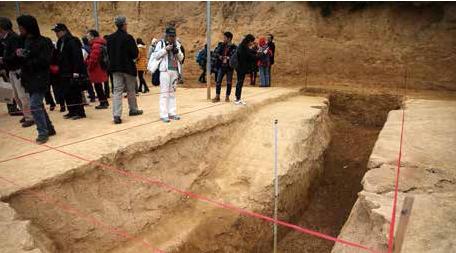良渚,是中华文明的重要源头
2019-07-26

游客在良渚博物院駐足观展。
上下五千年,这是为中国人熟悉的历史提法,但是,“五千年”的依据到底是什么?
司马迁在《史记》中把黄帝列为《五帝本纪》之首,作为古史的开端,才有了5000年的说法,但这只是一个没有被科学证实的传说。
20世纪20年代,考古学作为一门近代科学传入中国,中国的考古学者一直在解决一个问题,便是对“中华五千年文明”一说作出科学的验证。
如今,谜底解开——良渚文明所处的长江下游环太湖流域,与那些世界古代著名的文明发源地所处的纬度相当。
根据历史文献,中国的文明都是以大一统的夏王朝作为开始。根据夏商周断代工程,夏代开始的年代被暂定为公元前2070年。
但是,由于在于晚商阶段的殷墟发现了大量青铜器以及铭刻有文字的甲骨等遗物才被发现,因此,国际学术界一般都认为中华文明仅始于殷商时期,距今3600多年。
从良渚到商周,是中华文明从区域性文明向大一统逐步汇聚的一个连续不断的过程。
走过83年的良渚古城及水利系统的发现和持续性的考古工作,推动了学术界关于良渚文明和早期国家的讨论。
考古学者在世界早期文明的发生及中国文明化历程基础上,不断论述着良渚文明在城市规划与建设、土筑工程、水利、玉器、刻符、稻作、手工业、聚落分化等方面所取得的成就,指出良渚已进入成熟文明和早期国家阶段。
在距今5000年同时期的区域文明中,良渚文明的发育程度最高。
同时期苏北的大汶口文化和广东的石峡文化,以及更晚的龙山时代以至商代的玉器文化,都接受了来自“良渚”的巨大影响。
比如,江苏新沂花厅遗址和多处石峡文化遗址中,都可以看到良渚文化玉器、陶器与本地文化共存。
良渚文化的玉石器对稍晚的龙山时代诸文化产生了极大的影响,分布范围达到大半个中国,如山西陶寺遗址中的玉琮、“石厨刀”,陕北延安芦山峁、神木石峁的玉钺、玉璧,甘青地区齐家文化的玉琮、玉璧,都是良渚玉文化传播的产物。
因此,良渚文明是中华文明的一个重要源头,是中华文明多元一体中的重要一元。
(本文图片:CFP提供)
Liangzhu Culture:A Key Cradle of Chinese Civilization
“Five Thousand Years” is a concept about Chinese history familiar to most Chinese people in modern times. But is this understanding supported by facts? Where did this understanding first come from?

2017年12月,国际考古大咖实地考察良渚古城外围水利系统老虎岭水坝。
Sima Qian (c.145-c.86BC), a historian of the early Han Dynasty, mentions Yellow Emperor in his Records of the Grand Historian. The historian considered the emperor as the beginning of Chinese history, thus the 5,000 years. However, it is only a legend not supported by archaeological finds.
Since the 1920s when archaeology landed in China as a modern science, Chinese archaeologists have been trying to solve the 5,000-year myth. But for a long time, the archaeological research done by some Chinese scholars traced the Chinese civilization only to the Xia Dynasty which presumably started in 2070 BC. However, this study was controversial. The consensus of the international archaeological community was that the Chinese civilization started with the Shang Dynasty about 3,600 years ago.
Today, the genesis problem has been solved by the archaeological discovery of Liangzhu City in the Taihu Lake basin which is in the lower reaches of the Yangtze River in eastern China.

良渚古城遺址公园,一处良渚古人的雕像栩栩如生。
The Liangzhu Culture, unearthed and explored over a period of 83 years and still counting, boasts a city and a peripheral water conservancy system, among other important discoveries, which existed for about 1,000 years between 3,300 and 2,300 BC. The archaeological discoveries and studies have helped advance the discussion of issues such as the Liangzhu Culture and the regional early state.
On the basis of undisputable material evidence, archaeologists have long since concluded that Liangzhu was a mature civilization and a regional early state. Of all the regional cultures of that time in China, the Liangzhu Civilization was most advanced as evidenced by the palatial terraces, the city walls, the mega water-control system, and thousands of fine jade artifacts. Moreover, the social development of the Liangzhu State 5,000 years ago can stand side by side with ancient civilizations in other parts of the world.
The contemporary regional cultures, say, the Dawenkou Culture in the north of Jiangsu and the Shixia Culture in Guangdong, were all influenced by the Liangzhu Culture. Unearthed from these sites were local pottery pieces as well as jade and potteries from the Liangzhu Culture. The jade artifacts influenced many other younger cultures. The influences of Liangzhu reached many other regions of China, as testified by unearthed objects.
It is therefore safe to say that the Liangzhu Civilization is a key origin of the Chinese civilization and a key part representative of the “diversity in unity” of the Chinese civilization.
Liangzhu Culture around the Taihu Lake, the Hongshan Culture in Liaoning in northeastern China, the Shijiahe Culture in the north, the Taosi Culture in the south of Shaanxi, the Shimao Culture in the north of Shanxi, just to name a few important regional cultures across China.
About 6,000 years ago, regional cultures in China experienced fast and complex social and cultural development and urbanization. From 5,500 years to 4,000 years ago, many regional cultures became powerful. For a long time, the archaeological community thought that the Chinese civilization was largely along the Yellow River basin in the north and that the Xia and the Shang were the beginning of the Chinese civilization. This understanding diminished the historical significance of regional cultures far away from the Yellow River basin. Ample and convincing material evidences from recent archaeological excavations have changed peoples understanding of the Chinese civilization. Now it is agreed that Liangzhu is a perfect case study and that it is the first state civilization in China.
